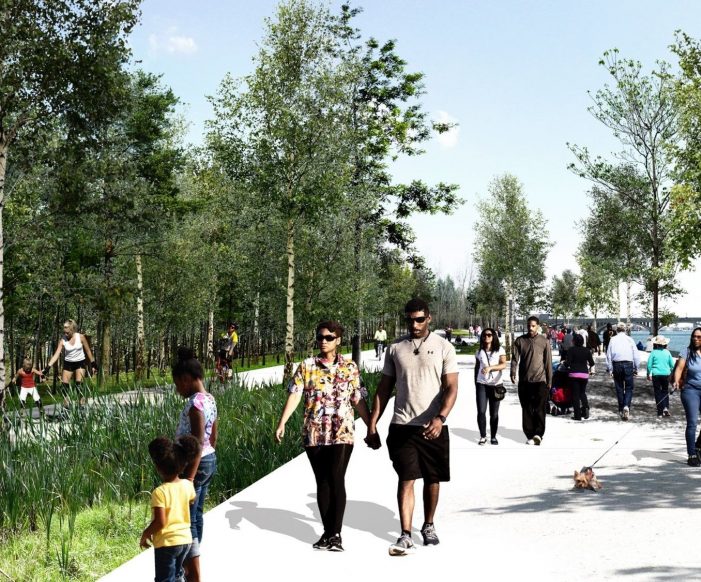By next fall you should be able to take the Riverwalk from the Joe Lewis Arena to Belle Isle.
The Detroit Riverfront Conservancy and its partners just broke ground for the Riverwalk extension along the Uniroyal site. It will complete the Conservancy’s vision of 3.5 miles of Riverwalk along the East Riverfront and connect the riverfront parks and Belle Isle.

The project is slated to be an $11 million investment and anticipated to be completed by fall of 2022.
It is the final piece of the Conservancy’s East Riverfront project.
“The Detroit Riverfront has changed the way that we come together as a city. Detroiters have fallen in love with the Riverwalk,” says Mark Wallace, Detroit Riverfront Conservancy president & CEO. “Once this final piece of the East Riverfront is completed, it will bring even more Detroiters together.”
There much to see. Check out the Aretha Franklin Amphitheater, Detroit Wayne County Port Authority, GM Plaza, Hart Plaza, Milliken State Park Lighthouse, Harbor and Wetlands, Mt. Elliot Park, Riverwalk Garden Rooms, Dequindre Cut, Outdoor Adventure Center and Stroh River Place and Talon Center, just to name a few of the adventures waiting.
The Detroit Riverfront Conservancy has invested more than $200 million in the revitalization of the Detroit Riverfront, which has generated more than $2 billion in public and private investment.
The Detroit Riverwalk was recently named Best Riverwalk in the country by USA TODAY 10Best Readers’ Choice Awards.

“When we started transforming the riverfront 20 years ago, we had an ambitious vision and our promise was to connect the entire East Riverfront,” says Matt Cullen, chairman, Detroit Riverfront Conservancy. “Today, we are proud to break ground and deliver on that promise. Our community came together around this project — and I am pleased to say that the founding partners — the City, The Kresge Foundation and General Motors — are still with us supporting the project today.
“This final piece along the East Riverfront is a lasting gift to the generations who live, work and visit Detroit and critical to our long-term vision of revitalization from bridge to bridge,” he says.
The project is being led by the Detroit Riverfront Conservancy, the City of Detroit, the Michigan Department of Transportation (MDOT), and the Environmental Protection Agency.
The Detroit Riverfront Conservancy’s founding partners, including the City of Detroit, The Kresge Foundation and General Motors, continue to support the Detroit Riverfront Conservancy 20 years later. In 2003, GM built the first section of the Detroit Riverwalk during the renovation of the company’s headquarters, the Renaissance Center.

General Motors contributed $2.5 million to help complete the final connection on the East Riverfront and provided the essential funding for the groundbreaking. In total, GM has invested $35 million in the Conservancy’s riverfront revitalization efforts.
“This is a once in a lifetime project and the transformation of the Detroit Riverfront over the last two decades has exceeded all expectations,” says Terry Rhadigan, executive director, communications and citizenship at General Motors. “General Motors is proud to have played a prominent role in this revitalization effort and we will continue to be a strategic partner to help sustain the great work that the Conservancy does for our community.”
Founding partner, The Kresge Foundation, made a $50 million matching grant in 2002 for the transformation of the Detroit Riverfront. The investment was the biggest gift in the Foundation’s history. This investment was met with an additional $110 million of philanthropic support and has stimulated over $2 billion of investment in the Detroit Riverfront.
“The celebration of this final piece falling into place represents a glorious, 3.5-mile-long testament to the region’s ability to come together to create a civic commons that will define Detroit’s waterfront for our children, grandchildren, and beyond,” says Rip Rapson, president and CEO of The Kresge Foundation
MDOT began working with the Conservancy in 2010 when plans were in development for Mt. Elliott Park. MDOT continues to be a partner and has activated funds to help pay for the Uniroyal project.

“For decades, the Uniroyal site has been synonymous with industrial contamination and inaccessibility to our waterfront,” says Detroit Mayor Mike Duggan. “Thanks to the cleanup efforts that have taken place and the great work of the Detroit Riverfront Conservancy, future generations will know this stretch as one of the most beautiful sections of Detroit’s international waterfront, which continues to be cited as one of the best in the world.”
The Uniroyal plant on this 42-acre site once employed 10,000 and closed in 1980. Next to it was the Michigan Stove company and right down the river was Parke Davis – the largest pharmaceutical company in the world. The Uniroyal plant was demolished in 1985 – clearing the last large scale industrial use of the riverfront.
This year is the Conservancy’s busiest construction year to date.
The Detroit Riverfront attracts 3.5 million visitors annually and has remained open every day during the coronavirus pandemic. Since March 2020, use of it has increased 20 percent and Dequindre Cut usage has increased by 40 percent.


